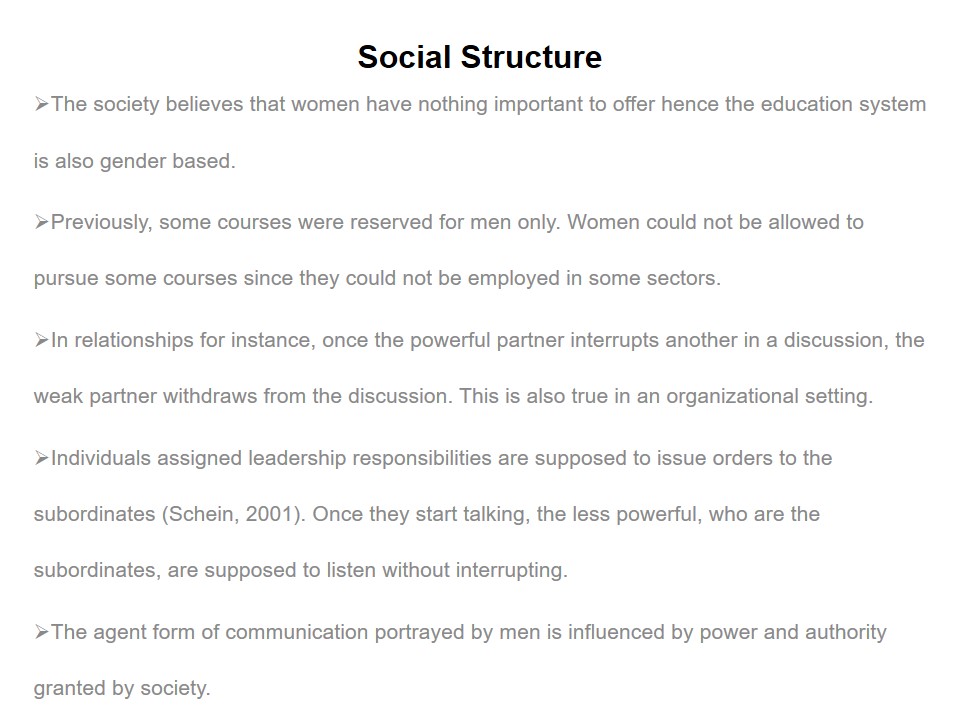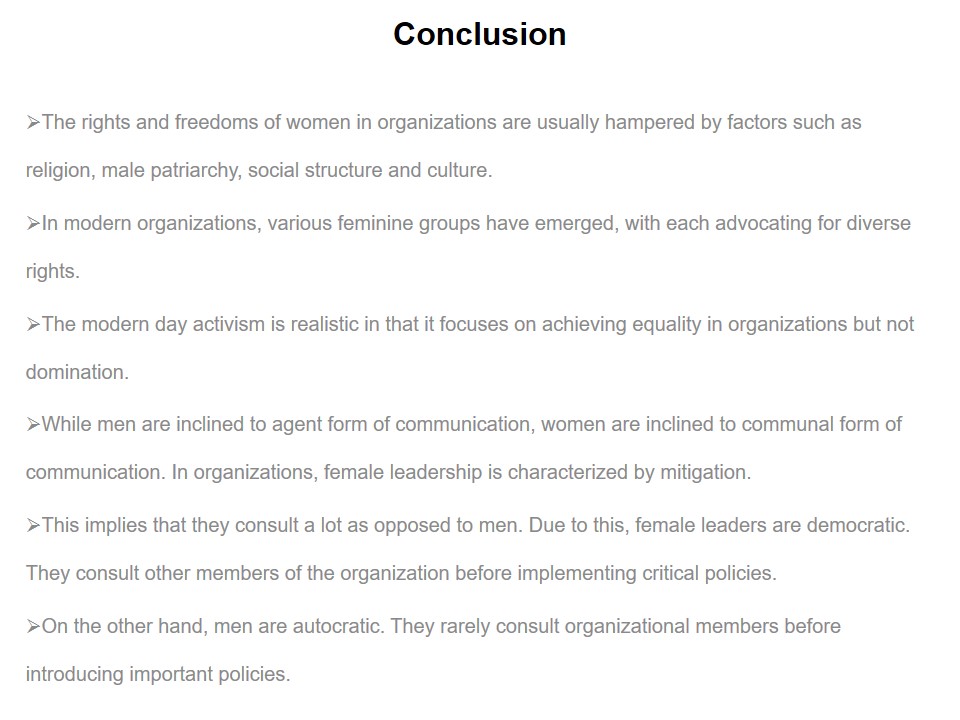Abstract
Various scholars have written extensively as regards to gender and language. Scholars claim that there is a difference between communication styles of women and men.
Tannen in her works You Just Don’t Understand (1990) argues that women communicate to strengthen their rapport with other members of the organization. In this sense, language is used to extend and maintain social connections.
The scholar further argues that men communicate mainly to report something or to pass certain information within the organization. In this regard, men use language to extend their domination and stamp authority in the organization.

Introduction
In the academic quarters, competing schools of thoughts have been identified since some argue that there are differences in communication while others claim there are no significant differences.
Popular articles and books about gender and communication concur with the fact that men and women behave differently in different situations (Heilman, 2004).
For instance, cultural labeling regarding gender depicts gender disparity. In other words, men are considered to be exercising an agent like communication while women are believed to be exercising communal like communication.

Research Problem
Although researchers have not studied enough regarding the effects of gender on communication, there is evidence that men try to practice asserting, governing and unenthusiastic communications.
On their part, women are known to exercise temperate, sympathetic and mutual communications.
Men attempt to exhibit high levels of visual supremacy that is closely related to power, authority and societal rank. This aspect is measured by the amount of time that an individual may perhaps maintain looking in the eyes of another individual in conservational progression.
It is also factual that men tend to ignore communications of others in organizations, not like women who are always keen to listen to people’s problems and concerns.
Men are known to issue directives that must be followed without complain. This paper will therefore discuss gendered communications in work places.
The paper tries to support the fact that women are inclined to communal communication while men are inclined to suppressive communication (Giacalone, & Riordan, 1990).

Gender Communication Review
Existing literature shows that men are likely to interrupt others during conservations, unlike women who are always keen to listen to the problems of staff members.
Such interruptions are aimed at intruding another person’s communication space in order to gain personal interests.
While in groups and in social places, men assert their authority by discussing about their professions and achievements (Friedman, 2004). Study of social interactions in places of work reveal some disparities as regards to gender communication.
Studies on social interactions confirm that women are inclined to communal communications while men are inclined to agency communications.
Men tend to portray a higher fraction of task behaviors and can directly go against another communicator while women portray positive actions in terms of social interactions.
To some extent, the actions of leaders tend to converge irrespective of gender, especially when some positions demand some values (Shackelford, Wood, & Worchel, 1996).

Forms of Gender Communication
Two meta-analytic analyses associated with communication found out that gender disparity is correlated to the expected patterns of behavior.
Women tend to be communally oriented while men are agent oriented. In this regard, female leaders in an organization tend to embrace egalitarianism meaning that their leadership style is democratic. In other words, women tend to involve other people in decision-making processes.
On the contrary, men are conservative implying that they employ autocratic styles of leadership. This system of leadership discourages involvement since the junior staff is not allowed to Participate in formulating critical policies.
Men tend to assert themselves in positions of power and try to frustrate others from ascending to power. Scholars have also confirmed that women leaders are transformational as compared to their male counterparts who are transactional.
Transformational leaders are known to mentor their staff and empower them to be effective in their lines of duties. This aspect demonstrates a sense of communality. Women in this case apply other forms of techniques in motivating the staff. They respect the culture of employees and encourage them to be innovative and creative.
On the other hand, men tend to be brutal and indifferent to the needs and sufferings of employees (Tannen, 1990). They actually apply a system of reward and punishment in motivating employees.

Features of Gender Communication
LaFrance, Hecht and Paluck (2003) suggest further that some features depicted by women show their communality. They are lovely, liberated, and socially helpful to others.
These scholars observed that there is a reasonable gender effect as regards to smiling and a little consequence regarding self-disclosure. In this regard, women tend to simile a lot and can easily give out personal information as compared to men.
Hall (2001) further concurred with LaFrance’s ideas through a study among married, college and university workers. Hall found out that women try to inspire other speakers to explain themselves by either nodding or orally buttressing other’s speech.
Mitigated language is termed as powerless by many scholars. Consequently, this shows the communality nature of women’s communication. This explains why women like involving others in their private affairs.
In an organization, employees would prefer leaders who use mitigated language to those who use other unscrupulous means. In this respect, scholars of communication observe that women tend to utilize mitigation in their leaderships. They may perhaps use some techniques such as equivocation, renouncing knowledge and adding questions to declarations.

Gender Composition Effects
Scholars have confirmed beyond doubt that gender disparities regarding communal and agent speech are consistent with labels regarding archetypal male and female actions.
However, gender roles rely on situational factors such as the communication context, including mixed or same-sex groups. Interrelationships between gender disparities in communication and gender masterpiece fundamentally replicate gender of partner effects.
This reveals that both men and women are gentle on women communicators (Hurst, 2007). A male and a female enjoy a cordial relationship as compared to same-sex communicators.
Hall concluded his study by observing that women treat each other warmly as compared to men. However, the treatment is expected to be the same in mixed-gender conversations. Furthermore, women and men disclose their information more to women than to men.
Pleasant voices and show of love in communication occur mostly in women conversations as compared to male or mixed-gender conversations.
This shows that people tend to adjust their communication depending on gender. Individuals evaluate the possible reaction of the other person and the effect of communication to him or her (Rudman, 1998).

Effects of Power on Gender Differences
Generally, men have power as compared to women. This power is sometimes legal due to the societal structure.
The society treats men differently by giving them superior roles. For instance, political, economic and social power is concentrated on the hands of men.
Politically, men control all forms of political organizations. Women are incorporated in such organizations as underdogs. Men also dominate societal wealth.
In the employment quarters, women are always mistreated because they are supposed to perform than men to be declared effective.
In management, women are considered ineffective and always depending on men for advices (Wood, 2005).

Social Structure
The society believes that women have nothing important to offer hence the education system is also gender based.
Previously, some courses were reserved for men only. Women could not be allowed to pursue some courses since they could not be employed in some sectors.
In relationships for instance, once the powerful partner interrupts another in a discussion, the weak partner withdraws from the discussion. This is also true in an organizational setting.
Individuals assigned leadership responsibilities are supposed to issue orders to the subordinates (Schein, 2001). Once they start talking, the less powerful, who are the subordinates, are supposed to listen without interrupting.
The agent form of communication portrayed by men is influenced by power and authority granted by society.

Conclusion
The rights and freedoms of women in organizations are usually hampered by factors such as religion, male patriarchy, social structure and culture.
In modern organizations, various feminine groups have emerged, with each advocating for diverse rights.
The modern day activism is realistic in that it focuses on achieving equality in organizations but not domination.
While men are inclined to agent form of communication, women are inclined to communal form of communication. In organizations, female leadership is characterized by mitigation.
This implies that they consult a lot as opposed to men. Due to this, female leaders are democratic. They consult other members of the organization before implementing critical policies.
On the other hand, men are autocratic. They rarely consult organizational members before introducing important policies.

References
Friedman, E. (2004). Issues of Gender. New York: Pearson Education.
Giacalone, R., & Riordan, C. (1990). Effect of self-presentation on perceptions and recognition in an organization. The Journal of Psychology, 124(1), 25-38.
Hall, J. (2001). Status, gender and non-verbal behavior in candid and posed photographs: A study of conversations between university employees. Sex Roles, 44(9), 677-692.
Heilman, M. (2004). Penalties for success: Reactions to women who succeed at male gender-typed tasks. Journal of Applied Psychology, 89(1), 416-427.
Hurst, C. (2007). Social Inequality (6th ed.) Boston: Pearson Education.
LaFrance, M., Hecht, M., & Paluck, E. (2003). The contigent smile: Meta-analysis of sex differences in smiling. Psychological Bulletin, 129(3), 305-334.
Rudman, L. (1998). Self-promotion as a risk factor for women: The costs and benefits of counter stereotypical impression management. Journal of Personality and Social Psychology, 74(1), 629-645.
Schein, V. (2001). Global loot at psychological barriers to women’s progress in management. Journal of Social Issues, 57(1), 675-688.
Shackelford, S., Wood, W., & Worchel, S. (1996). Behavioral styles and the influence of women in mixed-sex groups. Social Psychology Quarterly, 59(3), 284-293.
Tannen, D. (1990). You Just Don’t Understand: Women and Men in Conversation. New York: William Morrow.
Wood, J. (2005). Gendered Lives (6th ed.). Belmont: Thomson Learning.